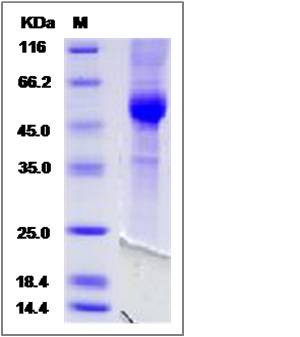Cynomolgus NKG2A / NKG2 / CD159A / KLRC1 Protein (Fc Tag)
KLRC1
- 100ug (NPP4438) Please inquiry
| Catalog Number | P90214-C01H |
|---|---|
| Organism Species | Cynomolgus |
| Host | Human Cells |
| Synonyms | KLRC1 |
| Molecular Weight | The recombinant cynomolgus KLRC1 is a disulfide-linked homodimer. The reduced monomer comprises 400 amino acids and has a calculated molecular mass of 44.4 KDa.The apparent molecular mass of the protein is approximately 47-55 KDa respectively in SDS-PAGE. |
| predicted N | Glu |
| SDS-PAGE |  |
| Purity | > 85 % as determined by SDS-PAGE |
| Protein Construction | A DNA sequence encoding the cynomolgus KLRC1 (Q9MZJ2) (Pro94-Leu233) was expressed with the Fc region of human IgG1 at the N-terminus. |
| Bio-activity | |
| Research Area | Epigenetics |Cell cycle |Cell division |Other cell division related protein |
| Formulation | Lyophilized from sterile PBS, pH 7.4. 1. Normally 5 % - 8 % trehalose and mannitol are added as protectants before lyophilization. Specific concentrations are included in the hardcopy of COA. |
| Background | NKG2, also known as NKG2A(CD159A), is a member of the killer cell lectin-like receptor family. This family is a group of transmembrane proteins preferentially expressed in NK cells. Members of this fmaily are characterized by the type II membrane orientation and the presence of a C-type lectin domain. NKG2 contains 1 C-type lectin domain and forms a complex with another family member, KLRD1/CD94. It is expressed only in NK-cells, but not in T-cells or B-cells. It has been shown that NKG2 represents a family of related cDNA clones, designated NKG2A, NKG2B, NKG2C, and NKG2D, which encode type 2 integral membrane proteins (extracellular C-terminus) containing a C-type lectin domain. Natural killer (NK) cells are lymphocytes that can mediate lysis of certain tumor cells and virus-infected cells without previous activation. They can also regulate specific humoral and cell-mediated immunity. NKG2 functions as a receptor for the recognition of MHC class I HLA-E molecules by NK cells and some cytotoxic T-cells. |
| Reference |
